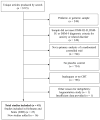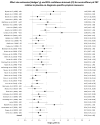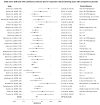Cognitive behavioral therapy for anxiety and related disorders: A meta-analysis of randomized placebo-controlled trials - PubMed (original) (raw)
Review
. 2018 Jun;35(6):502-514.
doi: 10.1002/da.22728. Epub 2018 Feb 16.
Affiliations
- PMID: 29451967
- PMCID: PMC5992015
- DOI: 10.1002/da.22728
Review
Cognitive behavioral therapy for anxiety and related disorders: A meta-analysis of randomized placebo-controlled trials
Joseph K Carpenter et al. Depress Anxiety. 2018 Jun.
Abstract
The purpose of this study was to examine the efficacy of cognitive behavioral therapy (CBT) for anxiety-related disorders based on randomized placebo-controlled trials. We included 41 studies that randomly assigned patients (N = 2,843) with acute stress disorder, generalized anxiety disorder (GAD), obsessive compulsive disorder (OCD), panic disorder (PD), posttraumatic stress disorder (PTSD), or social anxiety disorder (SAD) to CBT or a psychological or pill placebo condition. Findings demonstrated moderate placebo-controlled effects of CBT on target disorder symptoms (Hedges' g = 0.56), and small to moderate effects on other anxiety symptoms (Hedges' g = 0.38), depression (Hedges' g = 0.31), and quality of life (Hedges' g = 0.30). Response rates in CBT compared to placebo were associated with an odds ratio of 2.97. Effects on the target disorder were significantly stronger for completer samples than intent-to-treat samples, and for individuals compared to group CBT in SAD and PTSD studies. Large effect sizes were found for OCD, GAD, and acute stress disorder, and small to moderate effect sizes were found for PTSD, SAD, and PD. In PTSD studies, dropout rates were greater in CBT (29.0%) compared to placebo (17.2%), but no difference in dropout was found across other disorders. Interventions primarily using exposure strategies had larger effect sizes than those using cognitive or cognitive and behavioral techniques, though this difference did not reach significance. Findings demonstrate that CBT is a moderately efficacious treatment for anxiety disorders when compared to placebo. More effective treatments are especially needed for PTSD, SAD, and PD.
Keywords: anxiety; anxiety disorders; behavior therapy; cognitive therapy; meta-analysis; treatment outcome.
© 2018 Wiley Periodicals, Inc.
Figures
Figure 1
Flow diagram of study selection process
Figure 2
Effect size estimates (Hedges’ g) and 95% confidence intervals (CI) for acute efficacy of CBT relative to placebo on diagnosis-specific symptom measures. ASD = Acute Stress Disorder; GAD = Generalized Anxiety Disorder; OCD = Obsessive- Compulsive Disorder; PD = Panic Disorder; PTSD = Post Traumatic Stress Disorder; SAD = Social Anxiety Disorder.
Figure 3
Odds ratios (OR) and 95% confidence intervals (CI) for responder status following acute CBT compared to placebo. ASD = Acute Stress Disorder; GAD = Generalized Anxiety Disorder; OCD = Obsessive- Compulsive Disorder; PD = Panic Disorder; PTSD = Post Traumatic Stress Disorder; SAD = Social Anxiety Disorder. CIDI = Composite International Diagnostic Interview PTSD Module; CAPS = Clinician Administered PTSD Scale; CGI - S = Clinical Global Impressions Scale – Severity; CGI - I = Clinical Global Impressions Scale – Improvement; SRT = Symptom Rating Test; CSC = Clinically Significant Change (See Sharp et al., 1996, Foa et al., 1991, or Lucas, 1994); PCLS = PTSD Checklist; SRQ-20 = Self-Reporting Questionnaire; SPDS-S = Social Phobic Disorder Severity; SPDS-C = Social Phobic Disorder Change Form; FNE = Fear of Negative Evaluation Scale; SIAS = Social Interaction Anxiety Scale; CIC-SP = Clinical Impression of Change — Social Phobia Scale; LSAS-SR = Liebowitz Social Anxiety Scale.
Figure 4
Placebo-controlled effect sizes and 95% confidence intervals (CI) for disorder-specific, anxiety, depression and quality of life measures QOL = Quality of Life. ASD = Acute Stress Disorder; GAD = Generalized Anxiety Disorder; OCD = Obsessive- Compulsive Disorder; PD = Panic Disorder; PTSD = Post Traumatic Stress Disorder; SAD = Social Anxiety Disorder.
Figure 5
Odds ratios and 95% confidence intervals (CI) of treatment response for CBT compared by target disorder QOL = Quality of Life. ASD = Acute Stress Disorder; GAD = Generalized Anxiety Disorder; OCD = Obsessive- Compulsive Disorder; PD = Panic Disorder; PTSD = Post Traumatic Stress Disorder; SAD = Social Anxiety Disorder.
Similar articles
- Cognitive-behavioral therapy for adult anxiety disorders: a meta-analysis of randomized placebo-controlled trials.
Hofmann SG, Smits JA. Hofmann SG, et al. J Clin Psychiatry. 2008 Apr;69(4):621-32. doi: 10.4088/jcp.v69n0415. J Clin Psychiatry. 2008. PMID: 18363421 Free PMC article. - Long-term Outcomes of Cognitive Behavioral Therapy for Anxiety-Related Disorders: A Systematic Review and Meta-analysis.
van Dis EAM, van Veen SC, Hagenaars MA, Batelaan NM, Bockting CLH, van den Heuvel RM, Cuijpers P, Engelhard IM. van Dis EAM, et al. JAMA Psychiatry. 2020 Mar 1;77(3):265-273. doi: 10.1001/jamapsychiatry.2019.3986. JAMA Psychiatry. 2020. PMID: 31758858 Free PMC article. - The Effectiveness of Virtual Reality Exposure-Based Cognitive Behavioral Therapy for Severe Anxiety Disorders, Obsessive-Compulsive Disorder, and Posttraumatic Stress Disorder: Meta-analysis.
van Loenen I, Scholten W, Muntingh A, Smit J, Batelaan N. van Loenen I, et al. J Med Internet Res. 2022 Feb 10;24(2):e26736. doi: 10.2196/26736. J Med Internet Res. 2022. PMID: 35142632 Free PMC article. Review. - Treatment of Anxiety Disorders: A Systematic Review [Internet].
Swedish Council on Health Technology Assessment. Swedish Council on Health Technology Assessment. Stockholm: Swedish Council on Health Technology Assessment (SBU); 2005 Nov. SBU Yellow Report No. 171/1+2. Stockholm: Swedish Council on Health Technology Assessment (SBU); 2005 Nov. SBU Yellow Report No. 171/1+2. PMID: 28876726 Free Books & Documents. Review. - Interventions for common mental health problems among university and college students: A systematic review and meta-analysis of randomized controlled trials.
Huang J, Nigatu YT, Smail-Crevier R, Zhang X, Wang J. Huang J, et al. J Psychiatr Res. 2018 Dec;107:1-10. doi: 10.1016/j.jpsychires.2018.09.018. Epub 2018 Sep 29. J Psychiatr Res. 2018. PMID: 30300732
Cited by
- Towards a self-applied, mobile-based geolocated exposure therapy software for anxiety disorders: SyMptOMS-ET app.
González-Pérez A, Diaz-Sanahuja L, Matey-Sanz M, Osma J, Granell C, Bretón-López J, Casteleyn S. González-Pérez A, et al. Digit Health. 2024 Oct 24;10:20552076241283942. doi: 10.1177/20552076241283942. eCollection 2024 Jan-Dec. Digit Health. 2024. PMID: 39484648 Free PMC article. - The impact of exercise interventions on sleep in adult populations with depression, anxiety, or posttraumatic stress: review of the current evidence and future directions.
Szuhany KL, Sullivan AJ, Gills JL, Kredlow MA. Szuhany KL, et al. J Behav Med. 2024 Oct 30. doi: 10.1007/s10865-024-00532-z. Online ahead of print. J Behav Med. 2024. PMID: 39477903 - Addressing Mental Health in Rural Settings: A Narrative Review of Blueberry Supplementation as a Natural Intervention.
Venable KE, Lee CC, Francis J. Venable KE, et al. Nutrients. 2024 Oct 18;16(20):3539. doi: 10.3390/nu16203539. Nutrients. 2024. PMID: 39458533 Free PMC article. Review. - Internet-Delivered Cognitive Behavioral Therapy for Anxiety.
Onyeka OC, Riddle D, Bivins E, Armstrong G, Upshaw B, Rast C, Silva T. Onyeka OC, et al. Adv Psychiatry Behav Health. 2024 Sep;4(1):91-100. doi: 10.1016/j.ypsc.2024.05.003. Epub 2024 Jun 19. Adv Psychiatry Behav Health. 2024. PMID: 39440044 No abstract available. - Internet-delivered cognitive behaviour therapy for affective disorders, anxiety disorders and somatic conditions: An updated systematic umbrella review.
Käll A, Biliunaite I, Andersson G. Käll A, et al. Digit Health. 2024 Oct 7;10:20552076241287643. doi: 10.1177/20552076241287643. eCollection 2024 Jan-Dec. Digit Health. 2024. PMID: 39381818 Free PMC article. Review.
References
- Bakhshani NM, Lashkaripour K, Sadjadi SA. Effectiveness of short term cognitive behavior therapy in patients with generalized anxiety disorder. Journal of Medical Sciences. 2007;7:1076–1081.
- Bakker A, van Dyck R, Spinhoven P, van Balkom AJ. Paroxetine, clomipramine, and cognitive therapy in the treatment of panic disorder. The Journal of Clinical Psychiatry. 1999;60:831–838. - PubMed
- Bandelow B, Reitt M, Röver C, Michaelis S, Görlich Y, Wedekind D. Efficacy of treatments for anxiety disorders: A meta-analysis. International Clinical Psychopharmacology. 2015;30:183–192. - PubMed
- Barlow DH, Gorman JM, Shear MK, Woods SW. Cognitive-behavioral therapy, imipramine, or their combination for panic disorder: A randomized controlled trial. JAMA. 2000;283:2529–2536. - PubMed
- Barlow DH, Sauer-Zavala S, Carl JR, Bullis JR, Ellard KK. The nature, diagnosis, and treatment of neuroticism: Back to the future. Clinical Psychological Science. 2014;2:344–365.
Publication types
MeSH terms
Grants and funding
- R34 MH086668/MH/NIMH NIH HHS/United States
- R01 AT007257/AT/NCCIH NIH HHS/United States
- R21 MH101567/MH/NIMH NIH HHS/United States
- K01 DA035930/DA/NIDA NIH HHS/United States
- R34 DA034658/DA/NIDA NIH HHS/United States
- R34 MH099311/MH/NIMH NIH HHS/United States
- R34 MH099318/MH/NIMH NIH HHS/United States
- R21 MH102646/MH/NIMH NIH HHS/United States
- K23 MH100259/MH/NIMH NIH HHS/United States
- R01 MH099021/MH/NIMH NIH HHS/United States
LinkOut - more resources
Full Text Sources
Other Literature Sources
Medical




